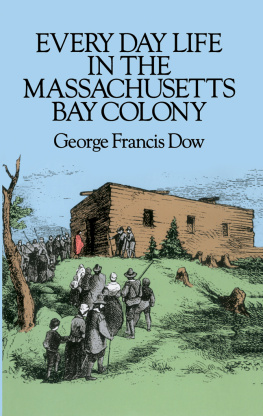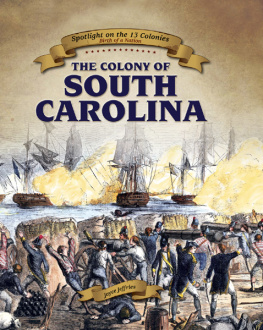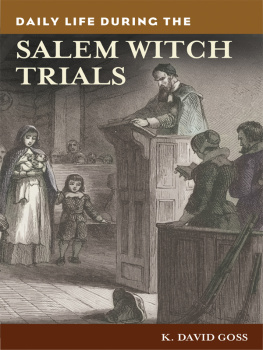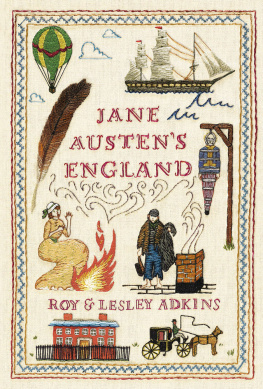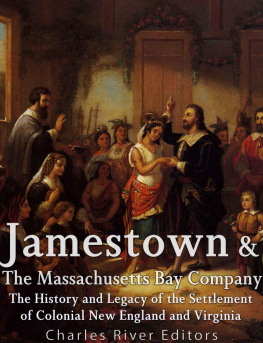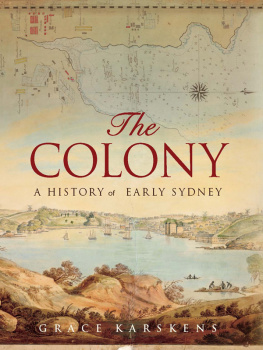Every Day Life in the Massachusetts Bay Colony

THE GOVERNORS FAYRE HOUSE IN THE 1630 COLONIAL VILLAGE AT SALEM
Every Day Life in the Massachusetts Bay Colony
GEORGE FRANCIS DOW

Massachusetts Bay Colony
Seal, 1675
Dover Publications, Inc., New York
This Dover edition, first published in 1988, is an unabridged republication of the work originally published by The Society for the Preservation of New England Antiquities, Boston, Massachusetts, in 1935, in an edition of 1000 copies. The map, which originally appeared on the endpapers, is, in this edition, placed immediately before Chapter I.
Manufactured in the United States of America
Dover Publications, Inc., 31 E. 2nd Street, Mineola, N.Y. 11501
Library of Congress Cataloging-in-Publication Data
Dow, George Francis, 1868-1936.
Every day life in the Massachusetts Bay Colony / George Francis Dow.
p. cm.
Reprint. Originally published: Boston : Society for the Preservation of New England Antiquities, 1935.
Includes index.
ISBN 0-486-25565-4 (pbk.)
1. MassachusettsSocial life and customsColonial period, ca. 16001775. I. Title.
F67.D68 1988
974.42dc19
87-25168
CIP
PREFACE
A PICTURE of some phases of life in the early days of the Massachusetts Bay Colony is presented in the following pages; lightly sketched, as much of the detail has become dim or has disappeared with the passage of years, it never having been placed on record even among the traditions. For why keep an exact record of doings with which every one is familiar? It follows that many of the every day happenings, the manners and customs of daily lifemuch of the intimate detail of existence in the Colony, in the seventeenth century, have been lost forever.
Few realize how modern are the furnishings and comforts of our present-day houses and how different was the home life of our ancestors. Chairs were unknown in ordinary English households until a generation or so before the sailing of the Mayflower. Hats were worn at meals and the use of table forks did not become general until the last of the 1600s. Food was placed in the mouth with the knife or the fingers. Washing the hands and face was not considered essential on rising from bed in the morning and few of the laboring classes in any country in Europe washed their faces every day.
This is a collection of source materials, somewhat digested, rather than a comprehensive, well-balanced narrative of daily life in the Colonyan impossible task at this late day. Moreover, the exact limitations of the Colonial Period have not been observed too closely as it has seemed desirable to include some material from newspapers and other later sources.
CONTENTS
ILLUSTRATIONS
Every Day Life in the Massachusetts Bay Colony
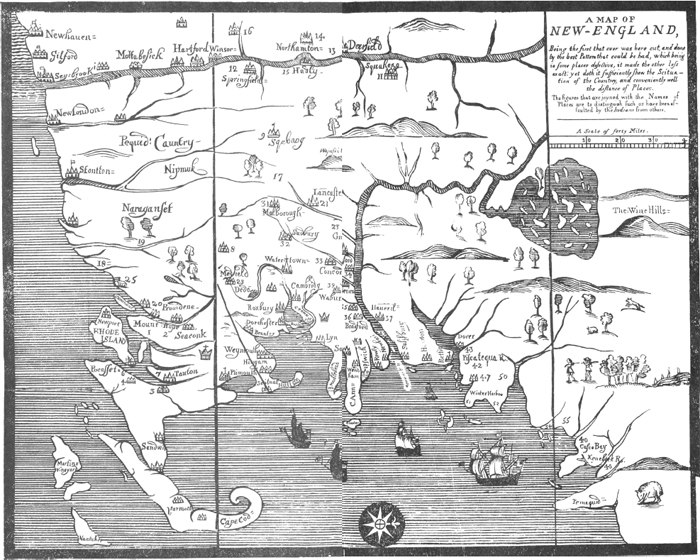
Every Day Life in the Massachusetts Bay Colony
CHAPTER I
THE VOYAGE TO MASSACHUSETTS
B EFORE you come, wrote Rev. Francis Higginson, the first minister at Salem, be careful to be strongly instructed what things are fittest to bring with you for your more comfortable passage at sea, as also for your husbandry occasions when you come to the land. For when you are once parted with England you shall meete neither markets nor fayres to buy what you want. Therefore be sure to furnish yourselves with things fitting to be had before you come: as meale for bread, malt for drinke, woolen and linnen cloath, and leather for shoes, and all manner of carpenters tools, and a great deale of iron and steele to make nails, and locks for houses, and furniture for ploughs and carts, and glasse for windows, and many other things which were better for you to think of there than to want them here. Elsewhere the good pastor set down A catalogue of such needfull things as every Planter doth or ought to provide to go to New England in which he enumerated the necessary victuals per person for the first year, viz.:
8 Bushels of meale, 2 Bushels of pease, 2 Bushels of Otemeale, 1 Gallon of Aquavitae, 1 Gallon of Oyle, 2 Gallons of Vinegar, 1 Firkin of Butter; also Cheese, Bacon, Sugar, Pepper, Cloves, Mace, Cinnamon, Nutmegs and Fruit.
The household implements listed were: 1 Iron pot, 1 Kettel, 1 Frying pan, 1 Gridiron, 2 Skellets, 1 Spit, Wooden Platters, Dishes, Spoons and Trenchers.
Mr. Higginson listed in detail the food supplies required per person for a year, including a good variety of spices; and also the clothing for a man, which included a Monmouth cap, a suit of canvas, a suit of freize, a suit of cloth, four pairs of shoes, three shirts and three falling bands, a pair of blankets, a coarse rug and seven ells of canvas with which to make a bed and bolster. The settler must also bring with him a complete armor, with a long piece, sword, bandoleer and ammunition, tools for cultivating the soil and for working wood, and also household implementsa limited equipment, comparable with the kit packed by the scout or mining prospector of more recent times.
On looking backward over the span of three centuries, Time lends an enchantment to these Puritan forefathers of present-day Massachusetts. Worshiping descendants have placed halos about their heads and the hardships of life during the early years have been magnified to the extent that these independent-minded Englishmen have become types of suffering fortitudemartyrs to the noble cause of free religion and self-government. That is a long tale, however, carrying with it many qualifications, and cannot be enlarged upon here. In what follows, it should always be borne in mind that aside from the Dutch at New Amsterdam and the small colony of Swedes on the Delaware, it was English stock that settled the American colonies and that these men and women brought with them a background of generations of English life. Their standards of living, manner of working their trades and natural aptitude for barter and commerce were all modeled upon English life and customs. It was only natural that this should be so. The ships crossed the Atlantic at comparatively frequent intervals and their holds came filled with all kinds of necessities and luxuries required by English standards of livingfoodstuffs, fabrics and implements which the shops of London, Plymouth or Bristol could supply and which could not be produced by the American settlements. To obtain these refinements of life the colonists required only money or merchandise. Lumber, raw or manufactured, salted fish, beaver and peltry, plantation-built vessels and other products of the colonies, could be easily converted into the comforts of English life for sale in the shops across the Atlantic.
The Rev. Francis Higginson came over in the Talbot, a ship of three hundred tons burden, which was armed with nineteen guns and carried a crew of thirty men. She brought over one hundred passengers. Sailing with her was the ship George of three hundred tons, in which came fifty-two passengers and a stock of cattle, twelve mares, thirty cows and some goats. From the original records of the Massachusetts Bay Company in New England we learn what food supplies were shipped on board the Talbot for the American voyage. The amount was supposed to be sufficient for one hundred and thirty-five men for three months. As a matter of fact, the voyage from Gravesend to the anchorage in Salem harbor occupied sixty-eight days.
Next page
